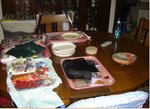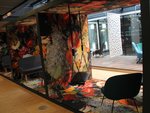







How does the design of your house or apartment help you live a healthy and connected life?
Kingfield resident Tasoulla Hadjiyanni has been studying this through her work as Northrop Professor of Interior Design at the University of Minnesota.
“Homes are among the primary settings where we live, cook, eat, play, socialize, pray, work, study, and engage in activities that give meaning to our life and determine our ability to thrive,” she observed.
Her latest book, “The Right to Home - Exploring How Space, Culture, and Identity Intersect with Disparities” features stories of Hmong, Somali, Mexicans, Ojibwe, and African Americans in Minnesota. It explores how elements of interiors support or suppress meaning-making.
Hadjiyanni focuses on the intersections of design, culture, and identity under conditions of displacement. Her own experience as a refugee from Cyprus as a child propelled her into this work.
“Bottom line is that we all eat, play, sleep, socialize, pray, work, rest, etc.– how we do these may be different,” pointed out Hadjiyanni. “As a result, there could be unexpected uses and unintended consequences of domestic environments.”
Connecting through stories
Hadjiyanni is an interior design scholar and educator – and she’s also a storyteller. “‘A story is the shortest distance between two people,”’ they say. So I create platforms for people to talk about their stories, I collect stories, and I find ways to share stories with diverse audiences,” she said. “These are often the stories of community members whose voices are not heard and whose stories are not known, such as refugees, immigrants, and minorities. I use interviews and focus groups primarily, including gathering stories inside peoples’ homes, as a way to see and better understand challenges people might be facing.” (See sidebar INSIDE 3 HOMES on page 7).
The physical realities of living space have big impacts on how people live. A kitchen layout may restrict cooking. The size of social areas limits gatherings with friends. A dining table can shape aspirations.
Hadjiyanni founded Culturally Enriched Communities to advocate for buildings that pave the way for social and racial justice. At the heart is a drive to create communities in which everyone can thrive.
Her award-winning scholarship and teaching pedagogies have been widely published, and used to decolonize design education.
“Home is more than housing,” she stressed. “It includes the ability of people to construct meaning inside their house – along with schools for their children to be educated, workplaces where they can earn an income and find purpose, parks to relax and exercise, and hospitals to heal their wounds. The spatial scales relevant to eliminating disparities range from the kitchen table (or lack thereof) to a room, a house, a neighborhood, a city, a nation, and the world.”
Landscapes of Hope
Her current work builds off the two crises of the COVID-19 pandemic and the murder of George Floyd, which occurred 12 blocks from her house.
The Landscapes of Hope project (www.cec-design.com/landscapesofhope/) includes a digital map of over 200 buildings in Minneapolis and St. Paul. Searchable by building type and location, the map enables easy access to design-related interventions for everything from affordable housing to streets. “At the same time, searching by location enables advocates from different neighborhoods of Minneapolis (North Minneapolis, Seward, Longfellow, Powderhorn, Lake Street, Hennepin Ave., Nicollet Ave., South Minneapolis, and Lyndale Ave.) and St Paul to see stories in their area, so they can form partnerships and synergies while giving visibility to the neighborhoods’ resilience,” said Hadjiyanni.
“I knew the neighborhoods and businesses impacted by the protests. I set out to share these stories in ‘Landscapes of Hope,’ because I know that the answers we are looking for in terms of how to move toward social justice are right here, in front of our eyes, if we know where to look.”
She added, “Many of these businesses are Black-owned, immigrant-owned, refugee-owned, family-owned, and women-owned restaurants, shops, daycares, and hair salons, along with organizations that pave the way for eliminating disparities and creating a just and equitable world.”
Minority-owned firms in Minnesota generated more than $8.7 billion in sales, pointed out Hadjiyanni, and Minnesota boasts close to 3,200 African immigrant businesses.
“Design can be used to strengthen everything from economic opportunities for Black and immigrant entrepreneurs through the development of thriving business corridors in BIPOC communities to health and well-being through parks that instill dignity and foster community,” stated Hadjiyanni.
Learn more at www.cec-design.com.
Comments
No comments on this item Please log in to comment by clicking here